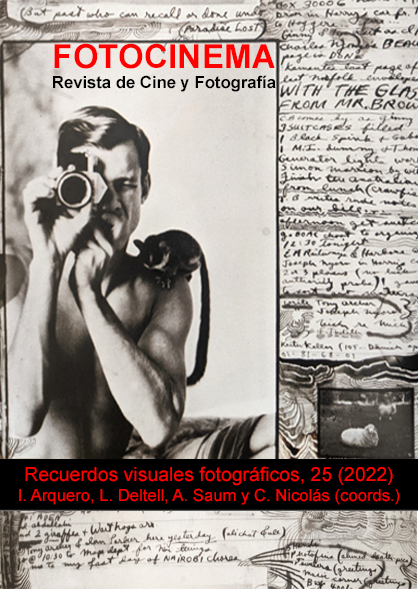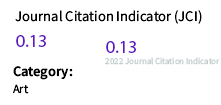Between Memory and Present Continuous: Photography Signs in Jordan Peele’s Get Out
DOI:
https://doi.org/10.24310/Fotocinema.2022.vi25.14198Keywords:
Photography, Filmic Representations, Digital Photography, Memory, Present Continuous, Get OutAbstract
This article is a reflection on the uses of photography represented in the film Get Out (Jordan Peele, 2017) that revive the past and develop the present of the characters. To do this, we analyze the photographic objects and acts, its temporal dimension and its social uses, its narrative and symbolic function, in the cinematographic discourse. In the film, the testimonial function of photography remains in digital photography, while enabling new practices, by the introduction of cell phone systems and Internet. Photography becomes in instant messages, autobiographical or not, driven by social interaction in the present continuous of virtual social networks. These photographic signs produce connections and tensions between past and present; have a symbolic dimension on the gaze as an object of desire to be snatched away, and on the changes in the production, diffusion and reception of the photographic medium.
Downloads
Metrics
Publication Facts
Reviewer profiles N/A
Author statements
Indexed in
-
—
- Academic society
- N/A
- Publisher
- Universidad de Málaga
References
Aguilar, G. (2015). Más allá del pueblo: imágenes, indicios y políticas del cine. Fondo de Cultura Económica.
Barthes, R. (1989). La cámara lúcida. Paidós.
Barthes. R. (1986). Lo obvio y lo obtuso. Paidós.
Bazin, A. (1990). ¿Qué es el cine? RIALP.
Berger, J. (1974). Modos de ver. Gustavo Gili.
Berger, J. (1998). Apariencias. En J. Berger y J. Mohr (Eds.), Otra manera de contar. Editorial Mestizo, pp. 81-130.
Berger, J. (2008). Mirar. Ediciones de la Flor.
Bourdieu, P. (2003). Un arte medio. Gustavo Gili.
Carlón, M. (2016). Registrar, subir, comentar, compartir: prácticas fotográficas en la era contemporánea. En P. Corro y C. Robles (Eds.), Estética, medios y subjetividades (pp. 31-54). Universidad Pontificia Católica de Chile.
Debord, G. (2002). La sociedad del espectáculo. Pre-textos.
Dubois, P. (1986). El acto fotográfico. De la recepción a la representación. Paidós.
Dubois, P. (2001). De una imagen del otro o de la influencia del cine en la fotografía creativa. Exit, 3, 130 y 161.
Fontcuberta, J. (1997). El beso de Judas. Gustavo Gili.
Fontcuberta, J. (2008). ¿Soñarán los androides con cámaras fotográficas? Ministerio de Cultura.
Fontcuberta, J. (2012). La cámara de Pandora. La fotografía después de la fotografía. Gustavo Gili.
Fontcuberta, J. (2016). La furia de las imágenes. Notas sobre las postfotografía. Galaxia Gutenberg.
Freeman, L. (2021). Cindy Sherman on Her First Ever Non-Photographic Works. Vogue. https://www.vogue.com/article/cindy-sherman-tapestries-exhibition-interview/amp
Gómez Cruz, E., y Meyer, E. (2012). Creation and Control in the Photographic Process: Iphones and the Emerging Fifth Moment of Photography. Photographies, 5(2), 203-221.
Huber, I. (2016). Present-Tense Narration in Contemporary Fiction: A Narratological Overview. Palgrave Macmillan.
Marzal Felici, J. (2010). Cómo se lee una fotografía. Cátedra.
Parejo, N. (2012). La expresión de lo fotográfico en el cine. En D. Acle Vicente, F. J. Herrero Gutiérrez; M. González de Ávila (Eds.), Expresión, análisis y crítica de los discursos audiovisuales: cine (pp. 65-80). Sociedad Latina de Comunicación Social. https://dialnet.unirioja.es/descarga/articulo/3951763.pdf
Peele, J. (Director). (2017). Get Out [Filme]. Blumhouse Productions; QC Entertainment.
Pultz, J. (2003). La fotografía y el cuerpo. Akal.
Ritchin, F. (2010). After Photography. W. W. Norton & Co.
Sorlin, P. (1992). Sociología del cine: La apertura para la historia de mañana. Fondo de Cultura Económica.
Sontag, S. (2009). Sobre la fotografía. Edhasa.
Stibbon, E. (2019). Andy Warhol: Cast os a Cold Eye / Polaroidfotografien. Bastian (2), 52-57.
Downloads
Published
How to Cite
Issue
Section
License
All contents published in Fotocinema Revista científica de cine y fotografía are protected under the Creative Commons Attribution-NonCommercial-ShareAlike 4.0 International (CC BY-NC-SA 4.0) license. All about this license is available in the following link: <http://creativecommons.org/licenses/by-nc-sa/4.0>
Users can copy, use, redistribute, share and exhibit publicly as long as:
- The original source and authorship of the material are cited (Journal, Publisher and URL of the work).
- It is not used for comercial purposes.
- The existence of the license and its especifications are mentioned.
There are two sets of authors’ rights: moral and property rights. Moral rights are perpetual prerogatives, unrenounceable, not-transferable, unalienable, imprescriptible and inembargable. According to authors’ rights legislation, Fotocinema. Revista científica de cine y fotografía recognizes and respects authors moral rights, as well as the ownership of property rights, which will be transferred to University of Malaga in open access. The property rights are referred to the benefits that are gained by the use or the dissemination of works. Fotocinema. Revista científica de cine y fotografía is published in an open access form and it is exclusively licenced by any means for doing or authorising distribution, dissemination, reproduction, , adaptation, translation or arrangement of works.
Authors are responsable for obtaining the necessary permission to use copyrighted images.














13.png)



